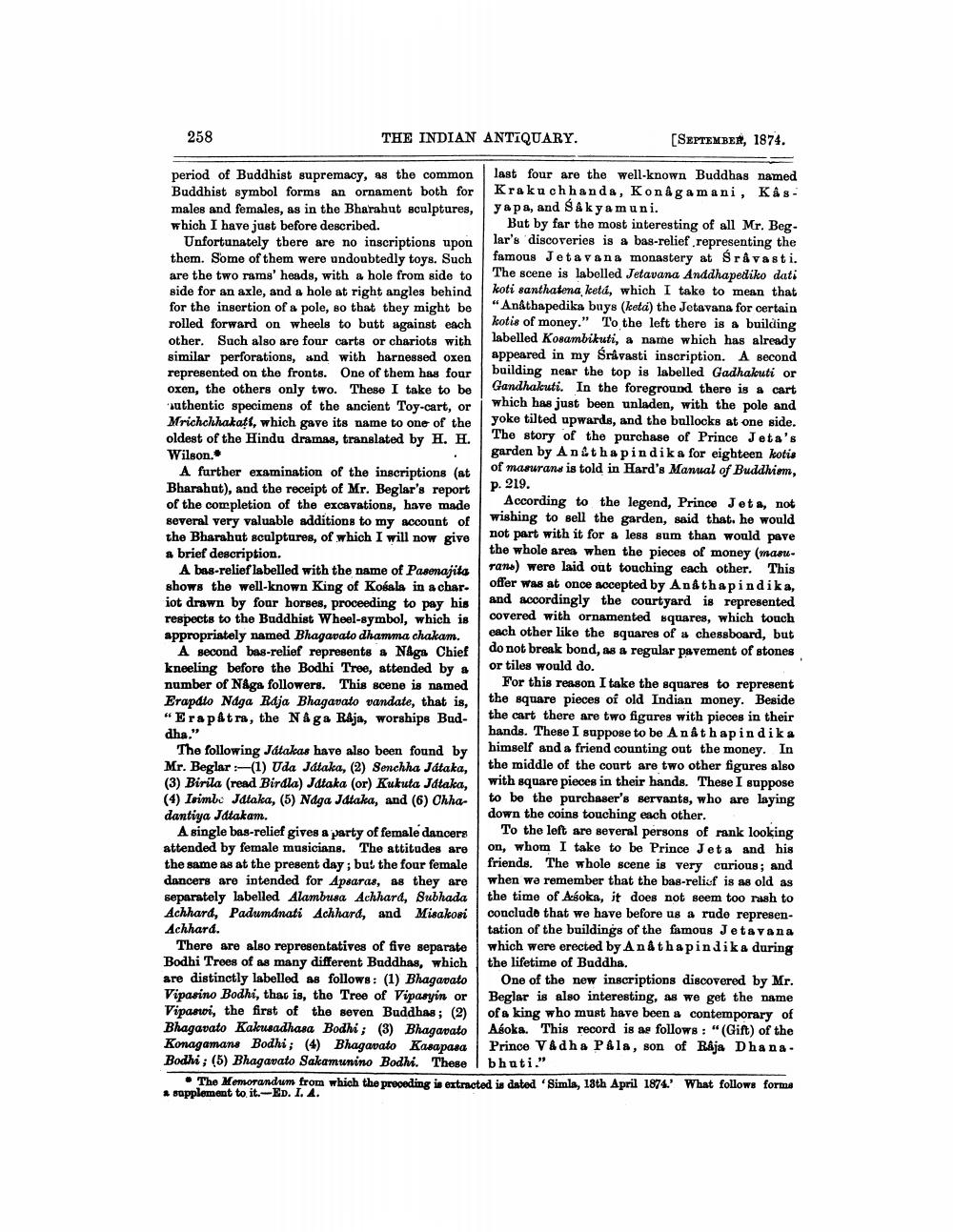________________
258
THE INDIAN ANTIQUARY.
[SEPTEMBER, 1874.
period of Buddhist supremacy, as the common last four are the well-known Buddhas named Buddhist symbol forms an ornament both for Kraku chhanda, Kongamani, Kâsmales and females, as in the Bharahut sculptures, yapa, and Sakya muni. which I have just before described.
But by far the most interesting of all Mr. BegUnfortunately there are no inscriptions upon lar's discoveries is a bas-relief representing the them. Some of them were undoubtedly toys. Such famous Jeta vana monastery at Śråvasti. are the two rams' heads, with a hole from side to The scene is labelled Jetavana Anddhapediko dati side for an axle, and a hole at right angles behind koti santhatena ketd, which I take to mean that for the insertion of a pole, so that they might be "Anathapedika buys (keta) the Jetavana for certain rolled forward on wheels to butt against each kotis of money." To the left there is a building other. Such also are four carte or chariots with labelled Kosambikuti, a name which has already similar perforations, and with harnessed oxen appeared in my Srivasti inscription. A second represented on the fronts. One of them has four building near the top is labelled Gadhaluti or oxen, the others only two. These I take to be Gandhakuti. In the foreground there is a cart uthentic specimens of the ancient Toy-cart, or
which has just been unladen, with the pole and Mrichchhakati, which gave its name to one of the
yoke tilted upwards, and the bullocks at one side. oldest of the Hindu dramas, translated by H. H.
The story of the purchase of Prince Jeta's Wilson.
garden by Anathapin dik a for eighteen kotis A further examination of the inscriptions (at
of masurans is told in Hard's Manual of Buddhism, Bharahut), and the receipt of Mr. Beglar's report
p. 219. of the completion of the excavations, have made
According to the legend, Prince Jots, not several very valuable additions to my account of
wishing to sell the garden, said that he would the Bharahut sculptures, of which I will now give not part with it for a less sum than would pave a brief description.
the whole area when the pieces of money (masu. A bas-relief labelled with the name of Pasenajita
rans) were laid out touching each other. This shows the well-known King of Kosala in a char.
offer was at once accepted by Anathapindika, iot drawn by four horses, proceeding to pay his
and accordingly the courtyard is represented respects to the Buddhist Wheel-symbol, which is
covered with ornamented squares, which touch appropriately named Bhagavato dhamma chakam.
each other like the squares of a chessboard, but A second bas-relief represents & Någa Chief do not break bond, as a regular pavement of stones kneeling before the Bodhi Tree, attended by a
or tiles would do. number of Någa followers. This scene is named For this reason I take the squares to represent Erapdto Ndga Rája Bhagavato vandate, that is, the square pieces of old Indian money. Beside "Erapatra, the Någa Raja, worships Bud- the cart there are two figures with pieces in their
hands. These I suppose to be Anathapin dika The following Játakas have also been found by
himself and a friend counting out the money. In Mr. Beglar :-(1) Uda Jataka, (2) Senchha Jataka,
the middle of the court are two other figures also (3) Birila (read Birdla) Jataka (or) Kukuta Jataka, with square pieces in their hands. These I suppose (4) Irimbo Jdtaka, (5) Naga Jataka, and (6) Chha- to be the purchaser's servants, who are laying dantiya Jatakam.
down the coins touching each other. A single bas-relief gives a party of female dancers To the left are several persons of rank looking attended by female musicians. The attitudes are
on, whom I take to be Prince Jeta and his the same as at the present day; but the four female friends. The whole scene is very curious; and dancers are intended for Apsaras, as they are when we remember that the bas-relief is as old as separately labelled Alambusa Achhard, Subhada the time of Asoka, it does not seem too rush to Achhard, Padumdnati Achhard, and Misakosi conclude that we have before us a rude represenAchhard.
tation of the buildings of the famous Jetavana There are also representatives of five separate which were erected by Anathapindika during Bodhi Trees of as many different Buddhas, which the lifetime of Buddha. are distinctly labelled as follows: (1) Bhagavato One of the new inscriptions discovered by Mr. Vipasino Bodhi, that is, the Tree of Vipasyin or Beglar is also interesting, as we get the name Vipaswi, the first of the seven Buddhas; (2) of a king who must have been a contemporary of Bhagavato Kakusadhasa Bodhi; (3) Bhagavato Asoka. This record is as follows: "(Gift) of the Konagamans Bodhi; (4) Bhagavato Kasapasa Prince Vadha P&la, son of Raja Dhana. Bodhi; (5) Bhagavato Sakamunino Bodhi. These bhuti."
• The Memorandum from which the preceding is extracted is dated Simla, 18th April 1874.' What follows forma # supplement to it.-ED. I. 4.
dha."




